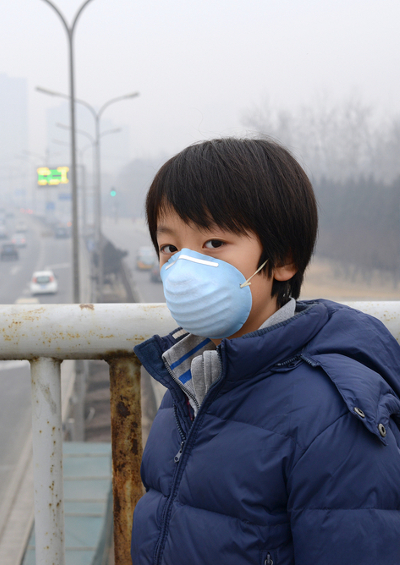TB in China: a New Epidemic of an Old Disease
How China handles drug-resistant tuberculosis will have a big effect on the problem globally.
May 31, 2014

Although considerable progress has been made, China now has one of the largest tuberculosis epidemics — second only to India — with more than 1.3 million new cases of tuberculosis every year.
What makes the situation particularly serious is that, according to the Chinese Center for Disease Control, China has the largest number of patients with Multiple Drug Resistant Tuberculosis (MDR-TB). Extensively Drug Resistant Tuberculosis (XDR-TB) is also widespread. These facts show the need to step up efforts to combat the disease.
In 1993, the World Health Organization (WHO) instituted a cost-effective treatment of tuberculosis called DOTS (a Directly Observed Treatment of a Short course of drugs) that very effectively combated TB in low-income countries. However, over time, patients began developing resistance to the drugs used for treatment, spreading MDR-TB.
The spread of TB’s stronger strain
According to the WHO, less than one-quarter of those believed to have MDR-TB have been diagnosed, facilitating the spreading of this serious form of the disease.
Tuberculosis becomes resistant to drugs in patients who don’t complete the treatment. The current treatment for non-resistant tuberculosis is relatively cheap and consists of medicine called first-line drugs for TB. In MDR-TB the patient is resistant to at least two of the most powerful anti-TB drugs.
This form of the disease costs much more to treat and its treatment course has more serious side effects, which explains patients’ reluctance to complete the treatment.
China’s mobile workforce makes for more itinerant diseases
China has a large migrant worker population who leave the countryside to join the wage economy in China’s main towns and cities.
Many of them practice unprotected sex and contract HIV/AIDS, which weakens their immune system and makes them more susceptible to tuberculosis. In addition, they live in conditions that facilitate the transmission of the disease and impede their diagnosis and proper treatment.
Many of these migrant workers cannot afford the cost of treatment in the cities and have to return to their place of birth, because subsidized management of tuberculosis (and other kinds of social welfare benefits) is only allowed in those areas where they were registered at birth.
Migrants born in rural areas cannot switch registration to become urban residents. Unfortunately, the rural healthcare system they are returning to does not match the quality of its urban counterpart.
Strides in Chinese healthcare
Although tuberculosis control has been part of the country’s public health program since the 1950s, it was only after the SARS epidemic in 2003 that the Chinese government tried to revitalize its tuberculosis control program. In that regard, the SARS epidemic benefited tuberculosis control by increasing political commitment to public health.
In March 2004, the government revised the law on control of infectious diseases, providing instructions on how to improve the reporting and implement interventions aimed at controlling those diseases.
This law helped by improving the reporting of tuberculosis at health facilities across the country. As a result, tuberculosis must be reported to local public health authorities within 24 hours of detection.
In January 2004, the Ministry of Health implemented the world’s largest internet-based communicable-disease reporting system, which allows tuberculosis patients to be rapidly identified to ensure their proper treatment. In addition, the Chinese government started a massive effort to improve public health facilities.
China must beef up the healthcare system to stop TB
Despite those efforts, however, China must do more. First, health workers must be better trained to implement the DOTS regime. Second, recording and reporting systems must be improved further. Third, the government must increase awareness about the dangers of the disease.
China should also make it a top priority to control the increasing numbers of MDR-tuberculosis patients. According to the WHO, China has a third of the world’s number of cases of MDR-TB, even though the country has only 15% of the global burden of disease.
To lower the prevalence of tuberculosis, particularly in its resistant forms, requires further improvement of the public health system.
Tuberculosis around the globe
The estimated prevalence rate of tuberculosis per 100,000 people fell from 215 in 1990 to 59 in 2013, and tuberculosis mortality rate declined steadily at an average rate of 8.6% between 1990 and 2010.
China now has the opportunity and obligation to continue these remarkable achievements. Its government, operating on a scale bigger than any other country, could also potentially make advances on the state involvement component of combating tuberculosis. That could in turn help other countries’ public health systems grapple with epidemics.
For example, MDR-TB also constitutes a serious problem In Russia. An analysis of 1,000 genomes from different TB isolates has shown that TB strains in Russia carry mutations that make them even more resistant to antibiotics and easier to spread, creating a complex public health problem.
Christopher Dye, an epidemiologist with the WHO in Geneva, Switzerland, has called the situation “truly scary.”
In a time when it has never been easier to carry a disease half way around the world – in less than a day – we would all do well to watch how countries around the world are grappling with drug-resistant tuberculosis.
The days of “consumption” being seen as the “romantic disease” of the European upper crust may be over, but globally, tuberculosis rages on today. And that’s a threat to public health everywhere.
Takeaways
China must advance healthcare even further to prevent the return of tuberculosis.
As tuberculosis becomes more resistant, China’s healthcare system must become more resilient.
How China handles drug-resistant tuberculosis will have a big effect on the problem globally.
Even in modern times tuberculosis rages on across the globe. And that’s a threat to public health everywhere.
The Chinese government could face a disaster in public health if it does not strengthen rural healthcare.
Read previous

Travelogue: Singapore Utopia
May 31, 2014
